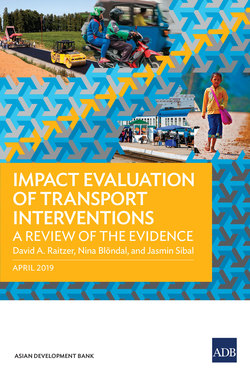Impact Evaluation of Transport Interventions

Реклама. ООО «ЛитРес», ИНН: 7719571260.
Оглавление
David A. Raitzer. Impact Evaluation of Transport Interventions
IMPACT EVALUATION OF TRANSPORT INTERVENTIONS
Contents
Tables, Figures, and Boxes
Foreword
Acknowledgments
Abbreviations
Key Messages
1. Importance of Impact Evaluation for the Transport Sector
2. Types of Transport Sector Interventions
3. Theory of Change for the Transport Sector
4. The Challenges of Evaluating Impacts of Transport Interventions
5. Impact Evaluations to Date
6. Common Impact Evaluation Designs in the Transport Sector
7. Outcomes Measured
8. Evidence Gaps
9. Future Studies
10. Conclusions
References
APPENDIX 1: EXAMPLE CASE STUDIES OF TRANSPORT SECTOR IMPACT EVALUATIONS
Case Study 1
Brief Overview
Intervention Evaluated
Outcomes and Theory of Change Evaluated
Methods Used
Treatment and Control Groups
Data Analyzed
Sample Size
Key Findings
Case Study 2
Brief Overview
Intervention Evaluated
Outcomes and Theory of Change Evaluated
Methods Used
Treatment and Comparison Groups
Data Analyzed
Sample Size
Key Findings
Case Study 3
Brief Overview
Intervention Evaluated
Outcome and Theory of Change Evaluated
Methods Applied
Treatment and Comparison Groups
Data Analyzed
Sample Size
Key Findings
Case Study 4
Brief Overview
Intervention Evaluated
Outcome and Theory of Change Evaluated
Methods Applied
Treatment and Comparison Groups
Data Analyzed
Sample Size
Key Findings
APPENDIX 2: OVERVIEW OF TRANSPORT SECTOR IMPACT EVALUATIONS
APPENDIX 3: SUMMARY DESCRIPTIONS OF MAJOR IMPACT EVALUATION METHODS. Difference-in-Differences and Fixed Effects
Synthetic Controls
Propensity Score Matching and Weighting
Regression Discontinuity Design and Interrupted Time Series
Footnotes
Отрывок из книги
A REVIEW OF THE EVIDENCE
David A. Raitzer, Nina Blöndal, and Jasmin Sibal
.....
Yet, many evidence gaps remain. Existing impact evaluation effort has mostly pertained to road development, of which rural roads are most frequently studied, and its effects on socioeconomic outcomes. There is much less attention to urban transport, and there is limited literature on non-road interventions. Efficiency and behavior change interventions central to the “avoid–shift–improve” approach, which seeks to reduce the need for travel, shift travel toward public transit, and reduce traffic bottlenecks, have also received less attention. Nor have effects via intermediate services, such as health or educational facilities, been often evaluated, when “corridor” approaches increasingly seek to link other investments with transport.
With “big data” increasingly available, it is hoped that the creative examples identified in this review can help to inspire new impact evaluation studies that address evidence gaps on transport. This work is more relevant than ever, as transport investments increasingly seek to experiment with high level technologies, such as intelligent transport systems, and increasingly focus on behavior change interventions, such as transport demand management, pricing, driving restrictions, and road safety measures. Impact evaluation can play a critical role to ensure that these innovations can be tested to help transport operations improve over time. This review helps to show where future impact evaluation investments can best fill evidence gaps and the methods that may be applied to do so.
.....